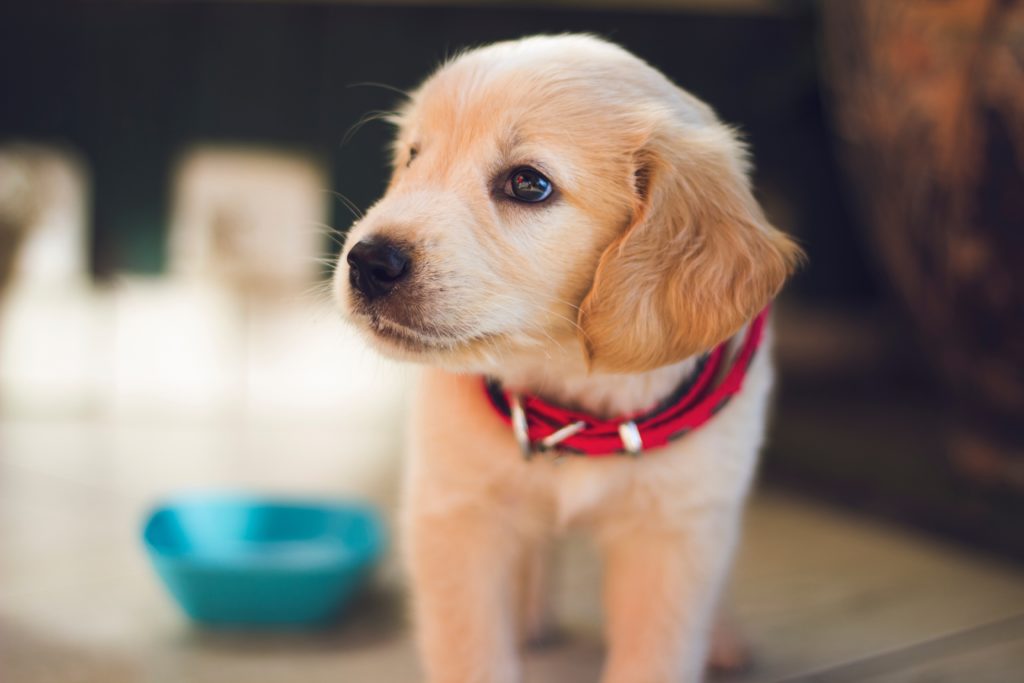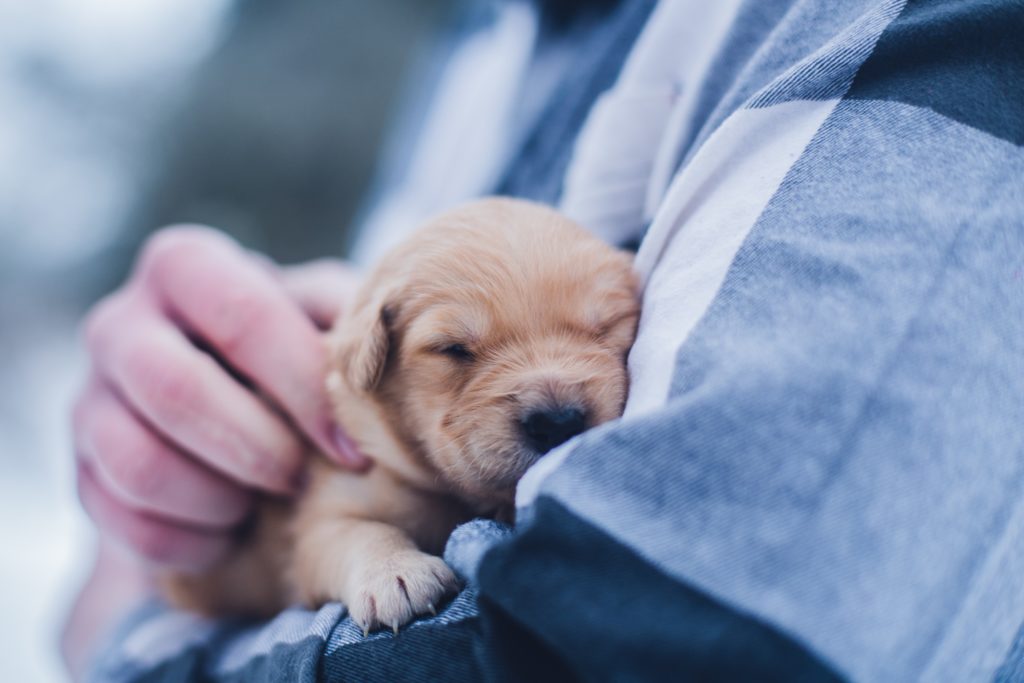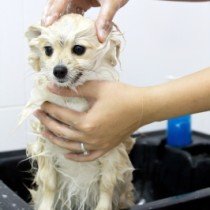A new puppy can make a great addition to any home. Although caring for a puppy takes a lot of work, raising one can be an incredibly rewarding and pleasurable experience. With the right care, your puppy will become well-adjusted to your house and make the perfect companion.
Whether raising a puppy for the first time or need a little reminder, this article will cover everything you need to know about caring for your new pet.
Contents
First Weeks: Preparing for Your New Puppy
There are a number of factors to consider before you introduce a new pet to your home.
Let’s cover the best ways to prepare your puppy and introduce it to your home, as well as some essential things to remember during your first few months.
1. Make Sure the Puppy is Right for You
Before purchasing and bringing a new puppy into your home, be sure to consider whether or not it’s the right choice for you.
Is it small enough to live in your house/apartment? How do its energy levels align with the amount of exercise you can provide it with? Does its coat suit the temperature of your climate?
By asking yourself these questions first, you can rest assured knowing that the puppy is appropriate for your lifestyle.
2. Make Your House Puppy Friendly
Be mindful that puppies, like babies, often explore new environments with their mouths. There are some precautions to take before bringing your pet home to prevent it from harm.
- Remove any breakable items from areas your puppy is going to be playing
- Keep any cables and wires up high and out of reach
- Close all low windows
- Hide away dangerous chemicals and cleaning products
- Invest in a trash can that’s too tall for your puppy to reach its head into
In addition to these measures, you should provide your puppy with a designated resting space. Dogs are territorial, so having its own space will put your pet at ease.
Some other things you’ll need to remember to purchase before collection include:
- Two stainless steel bowls – one for food, one for water. These are better than glass or ceramics as they won’t chip and bring harm to your puppy. If you have other pets, ensure that each has its own bowl to avoid conflict between them.
- A bed – either a crate with a pillow inside or a nest. Whatever you choose, make sure its soft, comfortable, clean and dry.
- Toys – plenty of chew toys and soft toys will give your puppy something to play with. Remember, newborns are full of energy. Provide your pet with a variety of fun toys, steering clear of rawhide, and it will enjoy playing with them all.
- Treats – small and easy-to-chew treats can be a great way to encourage a well-behaved puppy to keep up the good work. Purchase a variety of soft and crunchy snacks to help clean teeth whilst offering positive reinforcement to your pup.
- A nylon harness, flat collar and metal tag – poorly-sized collars will cause your puppy great discomfort so take care to make sure your measurements are exact. The tag should have your contact information clearly written upon it.
- You may also need a dog license, depending upon the law in your country.
3. Preparation Before Collection
The collection of your puppy can be quite a traumatic experience for it. It’s being taken away from its home and family, introduced to an entirely new environment and forced to adapt quickly to its surroundings.
You can help to ease this stress by preparing a few things for the journey. Some useful things to take with you are:
- A comfortable and size-appropriate dog carrier
- Blanket
- Water and/or food for longer journeys
- Spare bedding (in case the puppy urinates in fear)
These will ensure that your puppy feels comfortable and warm. As well as taking these items, you should also be mindful of your behaviour.
- Minimize or remove any sources of loud noise, like loud music or babies crying.
- Try to refrain from letting too many people handle the puppy, as this will only make it feel more stressed.
- Keep its environment well-ventilated.
- Be sure to stick to a socialization plan, sometimes provided by breeders, which aims to introduce new pets to unfamiliar environments and people gradually over a series of steps.
Caring for Your Puppy During the First Weeks
After you’ve introduced your puppy to your home, there are some extra measures that can be taken to ensure that your new pet develops happily and healthily.
4. Use a Dog Crate
When housing a new puppy, it’s important to have sleeping and eating arrangements in place. You can start by providing designated place for your puppy to sleep, like in the corner of your bedroom.
Dr. Carolyn Lincoln, dog trainer and vet, recommends using a dog crate to train your puppy to sleep through the night.
Place the crate near your bed or in an area close to you. Before settling down to sleep, let your puppy sit inside the crate for some time. Darken the room and quietly fall asleep without making a fuss about it.
“Your puppy will fall asleep when you fall asleep because he’s right there next to you. He can smell you. If he starts crying you can put your hand next to him,” says Lincoln
Over time, you can gradually move your puppy out of your room if you choose. Using a dog crate is an effective way to introduce your puppy to its new home without it feeling lonely at night.
This is especially important during the first few weeks to allow it to adjust to you.
5. Be Affectionate
New puppies will often be frightened when taken into a new home. In order to make it feel relaxed and at ease, give it plenty of love and affection.
Pet it often, stroking his head, legs and body multiple times throughout the day. This will help to create a strong bond between the two of you, as well as making it comfortable with being touched and handled.
Whilst showing plenty of love and affection, remember to handle your puppy with care. Like a baby, it is fragile. Scoop it up very gently and support its chest and bottom with both hands.
As well as this, begin to introduce your puppy to parts of the house such as the backyard and main rooms of the house on a tight leash over the first couple of days.
This will allow it to become explore its surroundings safely and in your company.
Photo by Lydia Torrey on Unsplash
6. Take Potty Breaks During the Night
Until your puppy is fully toilet trained, it will need to be let out in the night to urinate. It’s a good idea to place a pad inside your puppy’s crate just in case, although your puppy probably won’t like to soil the area they sleep in.
Sometimes, your puppy may try to wake you up before going to the toilet. If it does, simply let it outside or onto a mat calmly.
Don’t let it think it’s playtime. Giving it too much attention at night may cause it to wake up just to attract your awareness, rather than to go outside for the toilet.
Once you let your puppy out, stand still, let it urinate and say ‘good dog’ when it comes back in. Talk in gentle, calm tones. Then take it back up to bed without creating too much excitement.
Over time, your puppy will gain bladder control and won’t need to be let out so frequently. Generally speaking, puppies can hold their bladder for their age in months plus one, converted into hours.
A two-month-old puppy could go for three hours without urinating, a five-month-old for six hours, and so on.
7. Become a Morning Person
Lincoln also discusses how perhaps the hardest adjustment for first-time pet owners to make is that most puppies are very early risers.
“People think 5:30 am is the middle of the night. But puppies and children tend to naturally wake up around 5:30. You may have to just adapt to that,” she says.
“Get up. Let him out, feed him or play with him a bit and then he may want to go right back to sleep.”
8. Find a Good Vet
One of the first places that you and your puppy should go together is the vet. Your puppy will need a checkup to ensure that it is healthy and free from any serious health issues or birth defects soon after collection
To find a good vet, you can ask friends for recommendations or read online reviews of local services. Dogs collected from shelters or reputable breeders may also have owners with access to trusted veterinarians that they can share with you.
9. Make the Most Out of Your First Visit to the Vet
Vets are a great source of reliable information. They’ll be able to answer most of your questions about keeping your puppy happy, healthy and free from any problems.
Be sure to ask them which foods are best for your pet, how much and how often you should feed it, as well as anything else you’re unsure about. It’s important to clear everything up early on to prevent you from getting anything wrong and harming your pup.
Some other things to remember to discuss on your first visit are:
- Setting up a vaccination plan
- How to safely control and ward off both internal and external parasites/infections
- Learn how to spot early signs of illness
- Find out if and when you should spay or neuter your dog
10. Have Your Puppy Microchipped
As is customary with new puppies, you’ll need to get your pet microchipped.
Microchips are very small, often around the size of a grain of rice, and are placed just above the neck. These chips can then be registered with your contact information and address. If ever your puppy gets lost, the chip can be located and he’ll be brought right back to you.
It’s wise to have your puppy chipped even if you’re going to be using a collar, as chips cannot be removed.
Feeding Your Puppy
Learning how to feed a puppy can seem confusing in the beginning. Below are some simple tips for getting things right at mealtimes.
11. Shop for High-Quality Food
During its first year of development, your puppy’s body will be growing in many critical ways. Everything it eats will affect its health and vitality.
For that reason, it’s critical that you shop for high-quality puppy food. That’s puppy food, not dog food. Look out for a statement from the Association of American Feed Control Officials (AAFCO) on the packaging of food products to ensure that your selected feed meets your puppy’s nutritional requirements.
A high-quality puppy feed will have proteins from fish, chicken, beef, lamb or eggs. Your vet will be able to advise you on which foods are best for your particular pup.
Between 18 and 24 months, small to medium sized puppies can start to move from puppy food to adult dog food. Larger breeds may take a little longer, some even up to 2-years.
As well as providing adequate amounts of food, be sure to supply your puppy with fresh water at all times.
Foods to Avoid
When purchasing food for your pup, avoid any products containing corn or meat byproducts as their first listed ingredient. Pure meat should always be the first ingredient.
12. Feed Your Puppy The Right Way

You should give your puppy small quantities of food at regular intervals throughout the day. The amount of food you provide per meal will depend upon the breed and size of your pet, so take the time to research this thoroughly or seek professional advice.
Your puppy should be fed 3-4 times daily. This is because smaller meals are easier for pups to digest and it prevents their energy levels from spiking and falling too rapidly.
At around the six-month mark, you may begin to start feeding twice daily. You should always consult with a professional before making big changes to your pets feeding schedule.
13. Know When to Move Away From Puppy Food
Puppy food is very high in calories. If you feed your pet puppy food for longer than you have to, it may suffer from obesity and/or orthopaedic problems.
Your vet should be able to offer advice about when to make the switch to puppy food. You will know when the time is near when your puppy starts eating less of its food or begins to put on weight.
14. Stick to the Guidelines
Very small breeds, such as Yorkshire Terriers and Chihuahuas, can sometimes be prone to low blood sugar.
Such breeds will need access to food at all times or at very frequent intervals to prevent their energy levels from dropping, which can lead to weakness, confusion and sometimes even seizures.
Whether you’re housing a small or large puppy, seek professional help and make sure you stick to their guidelines.
15. Watch Your Puppy Eating
It’s important to watch your puppy as it eats while it’s still growing and developing. If your pet appears to lose its appetite or its eating habits change at all, you should make a note of this and report it to your veterinarian.
Small changes may only indicate changes in mood or energy levels. Sometimes, however, they can be a sign of a more severe medical concern.
It’s your responsibility to keep an eye on your pet’s eating habits and to inform your vet if you can see any significant changes. Early detection of illness is crucial for the longevity of your puppy.
16. Refrain From Feeding Your Puppy Leftovers
Human food can make your dog seriously unhealthy and/or obese – particularly foods high in fats. It isn’t designed for them to eat and, especially whilst your puppy is young, you should not feed it your leftovers.
Offering scraps also teaches your puppy to beg – an incredibly hard habit to break.
Whilst eating at the table, you should ignore your dog completely. Don’t encourage it to come near you searching for food.
As your puppy matures, you may wish to consult with a veterinarian and find out which human foods are safe to offer your dog. These might include salmon, carrots and apple.
17. Steer Well Clear of Toxic Foods
Whilst extra precautions can be taken to ensure that your leftovers don’t fall into your puppy’s jaws, sometimes mistakes are made. This isn’t usually a cause for major concern, but there are some foods that are highly-toxic to puppies and dogs.
These include:
- Grapes and raisins
- Garlic
- Alcohol
- Onion
- Avocado
- Chocolate
- Salt
Be sure to keep all of these foods well away from your puppy to prevent it from falling ill.
Raising a Happy and Healthy Puppy
As your puppy grows older, there are a few things you’ll need to consider to ensure that he develops both happily and healthily.
18. Make Sure Your Puppy Gets Plenty of Exercise
Depending on the breed of your pet, it will need varying levels of exercise. Bigger, more active German Shepherds will, of course, require more stimulation than smaller and more idle dogs like bulldogs.
After mealtimes, be sure to take your puppy out into the yard or garden on a tight leash and allow it to exercise its muscles.
When your vet deems it safe to do so, you can begin to take your puppy on short walks outside. Allow it to rest by taking long naps after walking to prevent its energy levels from falling too low.
Until fully developed, refrain from engaging your puppy in any strenuous exercise or overly-rough playing. After 9-months old, it will be developed enough to walk for a mile or longer.
Around an hour of daily walking will suffice in the beginning, split into 2-4 walks to prevent exhaustion. It’s important for your pet to interact with other dogs and people whilst walking, too, to begin the socialization process.
19. Start Working on Socialization
It’s a good idea to begin teaching your puppy socialization skills when your pet reaches 7-16 weeks of age. According to Dog Training Central, ‘This is the window of time in our puppy’s lives that determines who they will become as adult dogs.’
Your puppy should be allowed to meet and interact with many types of people, animals and environments (only after being vaccinated.)
In doing this, your puppy will be exposed to a range of different sounds and sights, learning that there’s nothing to fear and quickly becoming comfortable with its new home and environment.
Over time, your puppy will begin to feel at ease with being petted by strangers and meeting other dogs.
Socializing will help your puppy to develop happily and healthily. It will be less likely to go on to have behavioural problems later in life and will ensure that the two of you have a positive relationship with each other.
20. Keep Your Home Environment Puppy-Safe
Unclean or dirty home environments can encourage the spreading of infection or increase the possibility of injury. It’s vital that you keep things clean and tidy at home to prevent any harm from coming to your pet.
If your puppy urinates/defecates in the house, ensure to clean it up promptly. Replace any dirty or damp bedding as soon as possible to avoid the production of mould.
As well as keeping things hygienic, be mindful that some common houseplants can be highly toxic to dogs. These include:
- Aconitum
- Amaryllis bulbs
- Asparagus fern
- Azalea
- Cyclamen
- Daffodil bulbs
- Day lilies
- Delphiniums
- Foxgloves
- Hemlock
- Hyacinth
- Hydrangea
- Ivy
- Laburnum
- Lily of the valley
- Lupins
- Morning glory
- Nightshade
- Oleander
- Rhododendron
- Rhubarb leaves
- Sweet pea
- Tulip bulbs
- Umbrella plant
- Wisteria
- Yew
For a more comprehensive list of potentially harmful plants you can read the ASPCA’s guidelines here.
21. Consider Having Your Puppy Neutered or Spayed
Your vet may have specific recommendations about neutering or spaying your puppy, and this should only be considered after vaccination cycles are complete.
Sometimes, though, neutering/spaying may need to take place sooner. Larger breeds, for example, sometimes undergo spaying procedures before reaching 50-60 pounds.
Female dogs should also be spayed before their first heat cycle to reduce the risks of illness, according to the ASPCA.
22. Keep Your Eyes Peeled for Symptoms of Illness
Watch out for any signs that your puppy may be unwell and be sure to inform your vet. These may be symptoms such as loose stools, ill-looking eyes, mucus build up around the nostrils or frequent vomiting.
By keeping an eye out for early symptoms, illnesses can be dealt with quickly and effectively.
Training Your Puppy
As your puppy begins to settle, you’ll want to begin training it to follow certain rules, like urinating outside.
23. House Train Your Puppy
It’s crucial that you begin house-training your puppy from the moment you bring it home. Leave this any longer and it’ll only become a more difficult and messy task.
Over the course of the first few days, training pads can be used just in case. You should still take your puppy outside for the toilet, but pads can help as a backup.
Puppy’s have very small bladders and may even need to be let out every 30-60 minutes. You should keep an eye out for any signs that it needs the toilet, like trying to get your attention, and let it out promptly.
24. Create a Bathroom Routine
The most important thing you’ll need when starting a potty training regimen is patience. Accidents will happen, but patience and persistence will prevent them from happening over and over.
Ensure to offer plenty of positive reinforcement to your pet every time it successfully goes outside to the toilet. Speak in high, positive tones and give it lots of attention and occasional treats.
You should also try to maintain some regularity when letting your pet outside. Aim to keep to a similar schedule each day. Common times to let your pet out include:
- When you wake up
- Before bedtime
- After your puppy eats/drinks
- After physical activity
Over time, your pet will become accustomed to being let out at these times and know to hold its bladder until then.
Be mindful that, until your puppy has had all of its vaccinations (usually beginning at around 6-9 weeks old), you’ll need to let it outdoors in a place that’s inaccessible to other animals to prevent it from contracting any viruses or illnesses.
25. Teach Your Puppy to be Obedient
Teaching your puppy obedience is critical in the early stages of training to ensure that it obeys your commands. This will form the foundation of all future training attempts and help you and your puppy to build a stronger connection.
To begin, start by teaching your puppy to obey simple commands like sit and stay – these can be particularly useful in dangerous environments like roadsides.
As with potty training, offer lots of positive reinforcement with praise and treats. These are far more effective than punishment.
Once your pet reaches 4-6 months, it may be able to take part in puppy training classes to help it along.
26. Start Teaching Your Puppy A Few Basic Commands
Begin introducing your puppy to some basic commands, like teaching it to sit, come or lie down. These will help build a stronger bond between you and your pet whilst training it to become more obedient.
27. Train Your Puppy to Become Used to Car Journeys
By taking your puppy on regular trips out in the car, it’ll start to get used to travelling with you.
Some puppies may, however, become carsick. If this is the case, speak with your veterinarian about what measures can be taken to reduce sickness whilst travelling.
When travelling, ensure that your car is secured safely into its seat – either a regular car seat with a safety harness or dog seat to avoid injury.
Lastly, remember never leave your pet inside a hot car on warmer days. High temperatures can be fatal. On the other hand, overly cold temperatures during winter can cause illness, too. It’s vital that the temperature of your car is safe for your puppy.
28. Condition Your Dog to Love the Vets
Much of dog training is centered around conditioning. This is where you teach your pet to associate one stimulus with another, until both of those stimuli produce the same response.
For example, if you blow a whistle every time you feed your pet, eventually it will begin salivate from the sound of a whistle alone. In the same way, trained dogs associate sitting by the roadside, rather than running out, with treats and praise – so they sit by the roadside more often.
This same concept can be used to train your dog to love, rather than loathe, the vets. Bring toys and treats to you veterinary trips and be sure to offer your dog plenty of affection and praise.
Keeping Your Puppy Well-Groomed
While it’s a good idea to have your puppy professionally groomed every few months, it’s important to do a little grooming at home, too. This will help prevent fleas and other ailments like ingrown claws.
29. Brush Your Puppy’s Fur Every Day
By brushing your pet’s fur daily, you’ll be able to keep its fur clean and check for any skin problems. The type of brush you need will vary depending on the breed of your puppy, which will determine the thickness of its fur. You can check which brushtype you’ll need with your vet.
When brushing your puppy’s fur, remember to:
- Avoid brushing the face or legs with stiff brushes as these could inflict pain
- Brush all over your puppy gently, from its belly to hind legs
- In the beginning, brush only for a few minutes at a time to avoid overwhelming your pet
30. Trim Its Nails, Too
A professional groomer or veterinarian will be able to show you how to properly and safely trim your puppy’s nails. If you do this wrong, it can hurt or injure your pet. Your vet will also advise you on which type of nail trimmers to use.
You can begin trimming your puppy’s nails within the first week of it coming home. After trimming, file down jagged edges with an emery board
Overly long nails can put strain on four-legged animals’ wrists, as well as potentially damaging flooring, furniture and people/other pets.
You should aim to trim your puppy’s nails around every 1-2 months – that is, unless, your vet advises a different trimming schedule. As with any routine, you can use treats and praise to encourage good behaviour.
31. Keep Your Puppy’s Teeth and Gums Healthy
Chew toys, toothbrushes and toothpaste can all be used to maintain healthy gums whilst your puppy is developing.
Be sure to introduce brushing slowly and with plenty of praise and treats, making it as comfortable and positive an experience as possible for your pet.
32. Set Your Puppy Up For Success
By supervising your puppy at all times, letting it go outside when it needs to and keeping an eye out for any signs of ill health, you’ll be setting it up for success rather than failure.
Continue to praise positive behaviour and condition your pet to enjoy difficult tasks like going to the vets or being groomed with the use of treats. Give it plenty of love and time to improve your relationships with each-other.
With the help of all of the tips above, you can rest assured knowing that your new pet will go on to live a happy and healthy life in your company.

I have lived in big cities my entire life. Having grown up on the Upper East Side in Manhattan, my early life was an exciting one, filled to the brim with interesting encounters and opportunities popping up at every street corner. Like many city people, my passion for dogs first started when my parents decided to bring a puppy into the household. For them, it was a way of getting me to spend less time at his computer or wandering aimlessly around the city with my friends. Little did they know that bringing a Labrador Retriever into their apartment would determine not only the course of their son’s professional career but also my love life.
Having obtained a Computer Science Bachelor’s degree from Fordham University, I went on to pursue an IT career in the Big Apple. After a few years of doing basic cybersecurity and tech support work in various offices around Manhattan, I decided to leave New York and look for my calling in Boston, Massachusetts. There, I got a Master’s degree in Computer Science with a specialization in Web Development. As a means of supporting myself through college, he found a salesman job at a local paper company, where he met Mary, the love of my life and the person I’d end up creating My Sweet Puppy with.



![[HOW TO] Get Rid Of Puppy Worms Today](https://mysweetpuppy.net/wp-content/uploads/2020/09/How-much-should-I-feed-my-8-week-old-lab-puppy.jpg)


At how many weeks do I start training my puppy?
Many experts say that puppy socialization should start as early as 4 weeks old? Do you agree?
Thanks for connecting to Mysweetpuppy.net. Please keep in mind that I, Claudia Bensimoun, do not write any of the blogs or reviews on this website, nor have I in the past. I only answer the comments section.
I am in no way connected to the content written within this website, most especially the German Shepherd blog. This website hires other writers for their blogs.Please do not contact me regarding website content. I only write content within the comments section.
Positive puppy training begins the minute you bring your new puppy home. Potty training, crate training, and learning how to walk on a leash, are all part of puppy training. Having a puppy takes patience and plenty of kindness. Pups learn quickly, and you’ll need to make sure that your pup’s early associations are positive. Socialization is most important, and should begin as early as 4 weeks of age. Your puppy will need to get used to being held, being petted and handled, meeting new people, and being well-mannered around food and other animals. If you socialize your puppy early on in life, you’ll help to ensure your dog’s mental and emotional well-being throughout his life. Puppy parents can also combine virtual puppy training with on-site puppy training.
In my article with Victoria Stilwell, she mentions that ” “Virtual training can be a tricky proposition.”
“In certain cases with certain dogs, while trying to address very particular lessons or issues, it can be an effective tool, but it can also quickly morph into a problem scenario. For example, often a client will hire a dog trainer to ‘fix’ a given issue, only to find out from the trainer that there are far different (and sometimes more complicated) issues at play than the person was previously aware of. Virtual training generally doesn’t allow for the flexibility to address those types of issues.”
“It also makes the dangerous assumption that the dog owner and ‘virtual teacher’ are on the same page in terms of what they’re trying to address and how the dog responds to the training,” Victoria continues. “All too often, positive dog trainers see clients who miss important signals in their dogs, and virtual training creates a situation where there’s not a qualified dog behavior expert on hand to oversee the training process. Virtual training can only be considered for the most basic cues and language-building dog training – not any kind of behavioral issue.” For more on this article, visit:https://canadiandogs.com/is-virtual-dog-training-for-you/
Your pup will experience fear periods from 8-10 weeks of age, where he or she develops new fears. This happens again at 16-20 weeks, 6 months of age, 10 months, and then again at 14-18 months. Pups do best having controlled introductions to different situations, so that they do not become overwhelmed. Dogs need to have positive associations with their environment. Different noises, different surfaces, other animals, and new people all need to be gradually introduced. A great way is puppy Kindergarten classes. Never allow for the socialization process to become stressful for your puppy.
Lack of socialization and positive puppy training may lead to problematic behavior. That said, the C-BARQ Study is an online tool that pet parents use to fill out about their dog’s behavior. It is a canine behavioral assessment and research questionnaire. It is one of the largest studies involving more than 80,000 dogs, and discusses how a dog’s environment affects his behavior. Also how a dog’s parent or handler will affect the dog’s behavior.
For more information about my article on the C-BARQ Study, visit: http://www.usdaa.com/article.cfm?newsID=2851
For more information about dognition to help with training, visit https://www.dognition.com
how do i brush my puppys teeth
I am in no way connected to the content written within this website, most especially the German Shepherd blog. This website hires other writers for their blogs.Please do not contact me regarding website content. I only write content within the comments section.
Dental problems can occur in dogs in the same way that they do in people. Today, oral care for dogs is trending since it has become a big problem in dogs.Avoiding plaque buildup in dogs has become priority #1 since plaque results in tartar, gingivitis, and bone loss. With so many awesome canine dental products on the market today, there’s no reason why dogs should suffer from dental problems.Regular dental care, which includes preventative methods like brushing your dog’s teeth regularly, helps your dogs have healthy gums and teeth.
Oral health issues affect a dog’s body, and can lead to major health concerns.Pet parents should do their utmost to maintain their dog’s oral health. That said, dental issues can lead to periodontal disease and bigger problems, including larger veterinary bills. It also may result in heart and kidney disease in your dogs.
Gum disease is common in dogs today.
So what is gum disease in dogs?
This is a bacterial infection that affects the tissue around the dog’s teeth. Gum disease results in the inflammation of the dog’s gums, inflammation of the bone, and also of the ligaments that hold the teeth down. Daily brushing prevents the accumulation of bacteria at the gum line. Gingivitis and periodontitis are both forms of gum disease in dogs. Keep in mind that taking your dog to the veterinarian for twice yearly cleanings, helps to avoid dental disease in your pooch. Tooth brushing, along with dental chews, and a healthy diet help as well to prevent gum disease.
Signs of Gum Disease
.Inflammation of the gums, ligaments, and bones
.Tissue Breakdown
.Loss of a tooth’s supporting tissue
By the time a dog is two and a half, there is an 80% chance that he or she has periodontal disease, if there has been no preventative dental care.
Periodontal Disease in dogs
With this comes tissue damage, which results from years of plaque, tartar, and gingivitis. There is also tooth loss, with back teeth more prone to disease. Smaller dog breeds are also more affected by periodontal problems, more so than larger dog breeds. Upper teeth are also more often affected than lower teeth. Your veterinarian will need to do a professional cleaning above and below the gum line.
Signs of periodontal disease include the following:
.Bad breath
.Tissue damage which includes gums,bone,and ligaments.
Gingivitis
This is inflammation of the gums, due to a build-up of bacterial plaque. The ligaments and bone have not yet been affected.
Signs of Gingivitis
.Gums turning purple or red
.Gum edge bleeding on contact
.Bad breath
The most important part of dental care is to remember to brush your dog’s teeth, and to bring him or her in for twice yearly dental cleanings. Your veterinarian may also apply a sealant to your dog’s teeth, so as to avoid bacterial buildup. This will also help to speed up the healing process. Regular at-home oral hygiene maintenance is key to good dental health in your dogs. There are also numerous canine dental products like dental chews that work effectively with your dog’s chewing action to keep teeth clean. Canine oral products come in many flavors like beef, poultry, vanilla, and more. There are also plenty of gels and balms that can be applied directly to your dog’s teeth to protect them.
For more on canine dental care, visit:https://www.buzzfeed.com/davidmack/puppy-braceface
Thanks for connecting to Mysweetpuppy.net. Please keep in mind that I, Claudia Bensimoun, do not write any of the blogs or reviews on this website, nor have I in the past. I only answer the comments section.